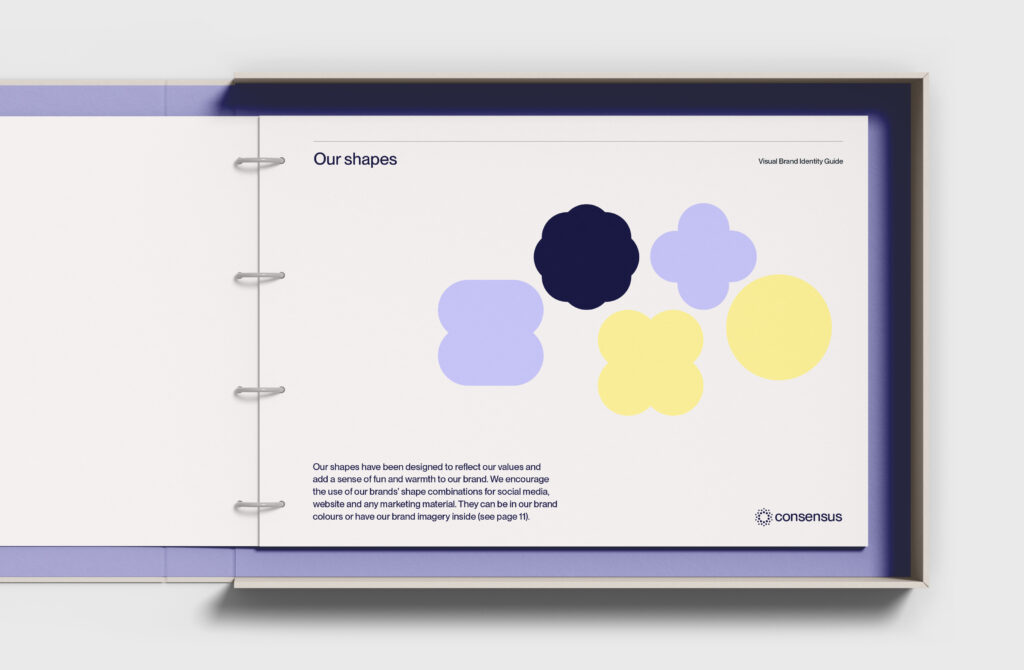Insight – 27/03/2024
Branding is still misunderstood by being reduced to its aesthetic component: visual identity. For many, whether specialists or not, branding is still just about the visual identity – name, logo, design, packaging, etc. Even more so, while the concept of branding and its understanding have evolved enormously over the years, the same old vision of branding is being preached, even by high-level marketers. In summary branding is the perpetual process of identifying, creating, and managing the cumulative assets and actions that shape the perception of a brand in stakeholders’ minds.
A business’s branding is more important than you might think. On the outside, your brand may seem like it consists only of elements such as logos and colors, but your brand is actually the entire identity of your business. Your brand gives you personality.
We’ve compiled a dictionary of branding terms to help you navigate the landscape and prepare the ground for a branding strategy that works for any New Zealand business. Knowing the lingo and branding terms will help you understand what’s relevant for your brand now, and what will become relevant once your brand grows and becomes more mature.

Brand
A mix of tangible and intangible attributes, symbolized in a trademark that can be managed to create value for organizations and customers. It is the physical representation of a company’s offerings and values, but can exist subjectively in a person’s mind. This is chiefly influenced by a person’s comparison of the brand promise offered versus their perception, experience, and interaction with an organization, product or service.
Brand ambassador
A brand ambassador is an individual who promotes and represents a brand with the aim of building awareness of the brand among their own target audiences and customers. They’re chosen because the brand believes the appointed Ambassador embodies its values, would connect with its target audience – and the collaboration will tap into the Ambassador’s own network of fans and followers digitally, or offline.
Brand architecture
- In essence, brand architecture is like a family tree for a brand. It shows the relationships between the parent brand, subsidiary brands, and all the products and services under those brands.
- It outlines the degree of interdependence and independence among the brands in a portfolio.
- It also serves as a roadmap for the brand offering, making it easier for customers to understand and connect with the brand.

Brand Extension
Brand extension is a marketing strategy wherein a company uses its existing brand name to introduce a new product or enter a new market segment. This strategy leverages the positive associations consumers have with the existing brand to promote the new offering.
Here’s an example: Let’s say there’s a popular brand of athletic shoes known for its high-quality running shoes. If the company decides to introduce a line of athletic apparel such as sports jerseys and shorts under the same brand name, that would be considered a brand extension.
The company benefits from the reputation and trust already established by its running shoes to attract customers to its new line of apparel. Similarly, if a well-known soft drink brand were to introduce a line of snacks, using its brand name recognition to promote the new products, it would also be a brand extension.
In essence, brand extension allows companies to capitalize on the equity built into their brand name to expand into related product categories or markets, potentially increasing their market share and revenue streams.
Brand Identity
Brand identity refers to the collection of elements that a company creates to portray the right image of its brand to the consumers. It encompasses all the visual, auditory, and sensory aspects that help consumers identify and differentiate the brand from its competitors. Here are some key components of brand identity:
Brand Name: The name by which the brand is known. It should be memorable, meaningful, and reflect the brand’s values and positioning.
Logo: A unique visual symbol or mark that represents the brand. The logo is often the most recognizable element of a brand’s identity and appears on all marketing materials, products, and communications.
Color Palette: The set of colors associated with the brand. Consistent use of colors helps reinforce brand recognition and evoke specific emotions or associations.
Typography: The style of fonts used in the brand’s logo, packaging, and marketing materials. Typography contributes to the overall look and feel of the brand and should align with its personality and message.
Visual Elements: Other visual elements such as imagery, graphics, and icons used in branding materials. These elements should be consistent and reinforce the brand’s identity.
Brand Voice and Tone: The style and manner in which the brand communicates with its audience. This includes the language, vocabulary, and personality expressed in written and verbal communication.
Brand Values and Personality: The set of principles and characteristics that define the brand’s identity and shape its interactions with consumers. Brand values and personality help establish an emotional connection with the target audience.
Packaging Design: The design of product packaging, which plays a crucial role in conveying the brand’s identity and attracting consumers’ attention on the shelf.
Together, these elements form the brand’s identity and help create a consistent and cohesive brand image that resonates with consumers and distinguishes the brand in the marketplace.

Brand Message
A brand message is the central idea or theme that a company communicates to its target audience about its products, services, and overall brand identity. It encapsulates the brand’s values, benefits, and unique selling propositions in a concise and memorable way. A strong brand message effectively conveys what the brand stands for and why consumers should choose it over competitors. Here are some key elements of a brand message:
Value Proposition: The core benefit or value that the brand offers to its customers. This could be functional (e.g., high quality, affordability) or emotional (e.g., luxury, belonging).
Differentiation: What sets the brand apart from competitors and makes it unique. This could be based on product features, innovation, customer service, or brand personality.
Target Audience: The specific group of consumers the brand is trying to reach and resonate with. Understanding the needs, preferences, and behaviors of the target audience is essential for crafting a relevant brand message.
Brand Promise: The commitment or guarantee that the brand makes to its customers. This could be related to product performance, customer satisfaction, or overall brand experience.
Brand Personality: The human traits and characteristics associated with the brand. This influences the tone, voice, and style of the brand message, helping to create an emotional connection with consumers.
Consistency: The brand message should be consistent across all communication channels and touchpoints, including advertising, packaging, website, social media, and customer interactions.
Memorability: A strong brand message is easy to remember and resonates with consumers long after they’ve encountered it. This could be achieved through catchy slogans, memorable taglines, or compelling storytelling.
Overall, a well-crafted brand message effectively communicates the essence of the brand to its target audience, helping to build brand awareness, loyalty, and trust over time.

Brand Experience
Brand experience refers to the sum total of all interactions and touchpoints a consumer has with a brand throughout their journey—from initial awareness to post-purchase interactions. It encompasses both tangible and intangible elements and influences how consumers perceive, feel, and remember the brand. Here are some key aspects of brand experience:
Physical Environment: The physical spaces where consumers interact with the brand, such as retail stores, offices, or event venues. The design, layout, and ambiance of these spaces contribute to the overall brand experience.
Digital Presence: The brand’s online presence, including its website, social media profiles, mobile apps, and other digital platforms. A seamless and user-friendly digital experience enhances brand perception and engagement.
Product or Service Quality: The quality and performance of the brand’s products or services directly impact the overall brand experience. Consistent delivery of high-quality products/services builds trust and loyalty among consumers.
Customer Service: Interactions with customer service representatives, whether in-person, over the phone, or online, play a crucial role in shaping the brand experience. Positive customer service experiences can strengthen brand affinity and advocacy.
Brand Communications: The messaging and content communicated by the brand through advertising, marketing campaigns, email newsletters, and other channels. Clear, authentic, and relevant communication fosters a deeper connection with consumers.
Brand Identity: The visual and verbal elements that represent the brand, including the logo, color scheme, typography, and brand voice. Consistency in brand identity across all touchpoints reinforces brand recognition and trust.
Emotional Connection: Brands that evoke positive emotions and resonate with consumers on a deeper level tend to create more meaningful brand experiences. Emotional connections can be established through storytelling, shared values, and personalized interactions.
Sensory Stimuli: The sensory elements associated with the brand, such as sight, sound, touch, taste, and smell. Leveraging sensory stimuli in branding initiatives can enhance memorability and engagement.
By focusing on delivering positive, consistent, and memorable brand experiences across all touchpoints, companies can cultivate strong relationships with consumers, foster brand loyalty, and differentiate themselves in the marketplace.
Brand Strategy
Brand strategy refers to a long-term plan devised by a company to establish and differentiate its brand in the marketplace, with the ultimate goal of achieving a competitive advantage and building brand equity. It encompasses various elements that guide how the brand is positioned, perceived, and communicated to its target audience. Here are the key components of a brand strategy:
Brand Positioning: Determining the unique space the brand occupies in the minds of consumers relative to competitors. This involves identifying the brand’s target market, understanding consumer needs and preferences, and articulating the brand’s value proposition and key differentiators.
Brand Identity: Developing a distinct and cohesive brand identity that reflects the brand’s personality, values, and attributes. This includes elements such as the brand name, logo, color palette, typography, and visual style.
Target Audience: Defining the specific demographic, psychographic, and behavioral characteristics of the audience the brand aims to reach and resonate with. Understanding the target audience enables the brand to tailor its messaging and experiences effectively.
Brand Architecture: Establishing the structure and hierarchy of brand offerings within a portfolio. This may involve creating sub-brands, extensions, or variants to address different market segments or product categories while maintaining coherence with the master brand.
Brand Messaging: Crafting compelling and consistent messaging that communicates the brand’s value proposition, benefits, and personality across various touchpoints and communication channels. This includes taglines, slogans, mission statements, and brand stories.
Brand Experience: Designing and delivering positive, memorable, and differentiated experiences that engage consumers at every stage of the customer journey. This encompasses interactions with the brand’s products, services, employees, physical and digital environments, and customer support channels.
Brand Guidelines: Establishing guidelines and standards for how the brand should be represented and communicated internally and externally. This ensures consistency in brand identity, messaging, and visual elements across all brand touchpoints and marketing materials.
Brand Extension and Innovation: Identifying opportunities for brand extension into new product categories or markets, as well as fostering innovation to keep the brand relevant and competitive in a dynamic business environment.
Brand Management and Monitoring: Implementing processes and metrics to monitor and manage the brand’s performance, perception, and reputation over time. This involves tracking brand equity, awareness, loyalty, and sentiment, and making adjustments to the brand strategy as needed.
Overall, a well-defined brand strategy serves as a roadmap for building and strengthening the brand’s relationship with consumers, driving business growth, and sustaining competitive advantage in the marketplace.
Say Hello!
Studio Nine
33-45 Hurstmere Rd
North Shore, Takapuna
M. +64 21 1306 713
katrina@studionine.co.nz
© Studio Nine
Branding & Graphic Design NZ

